Reds for fall and foliage power
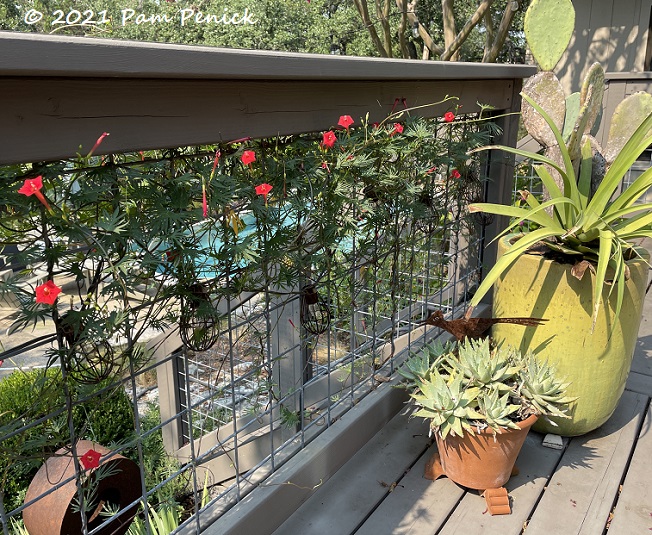
Ah, end of summer in Texas, and fall only a few weeks away. It’s still a bit too early for the fresh flowering of our “second spring,” but festive reds blaze among the ferny foliage of cypress vine (Ipomoea quamoclit) on the deck railing.
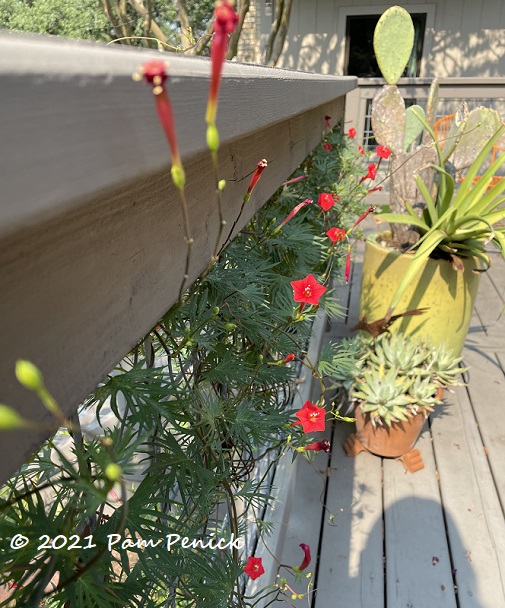
Everyone warns me about the aggressive reseeding of this annual vine. But I find it’s a bit thirsty, and unless seedlings are nurtured with extra water, they just don’t take off in my garden. I do nurture this one (not seed-grown) to attract hummingbirds that we can view from inside the house.
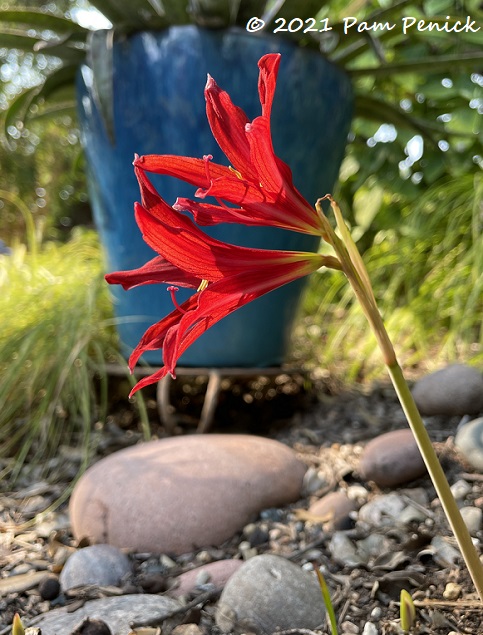
Jolts of red are also appearing behind the house, where a few oxblood lilies (Rhodophiala bifida) have popped up. They really need a good rain to put on a show, and we just haven’t had any lately. But even a few oxbloods are better than no oxbloods!
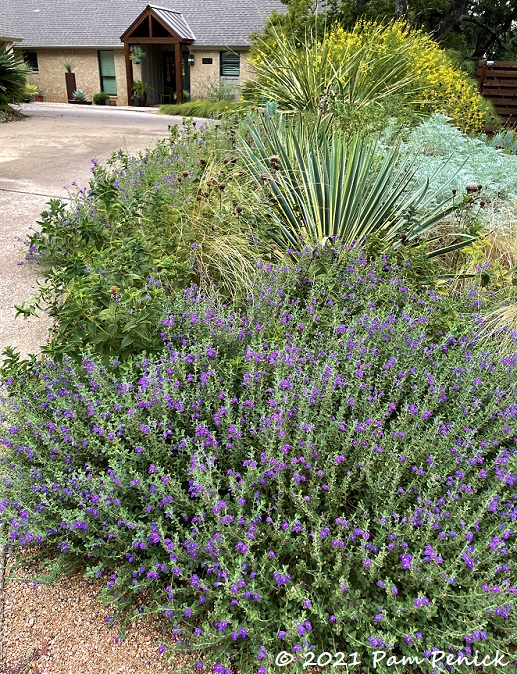
Out front, the driveway bed in full summer flower looks amazingly lush, considering how hard hit everything was by the epic February freeze. All of this holds up to constant deer pressure. My fave is the native purple skullcap (Scutellaria wrightii) in front, which thrives in baking hellstrip heat and with every dog in the neighborhood stopping to mark it. Behind are ‘Bright Edge’ yuccas, Mexican feathergrass, ‘Peter’s Purple’ monarda, ‘Powis Castle’ artemisia, Texas sotol (Dasylirion texana), and golden thryallis (Galphimia gracilis).
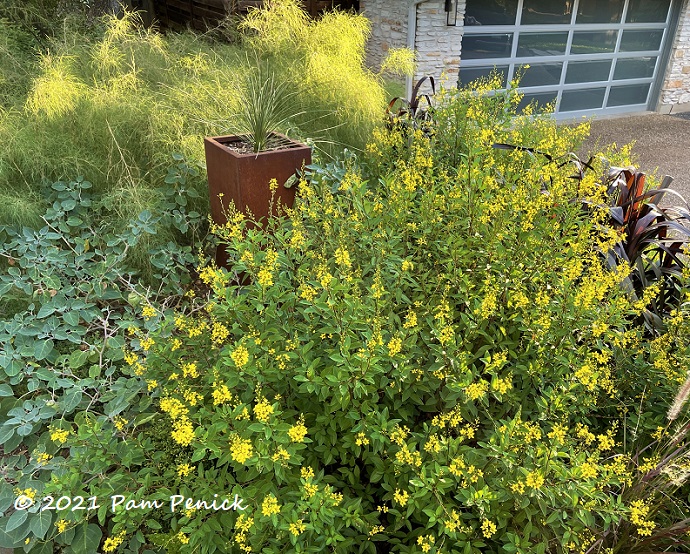
Behind the golden thryallis are datura (Datura wrightii), bamboo muhly (Muhlenbergia dumosa), and ‘Vertigo’ pennisetum. The tall corten pot in the center holds a young toothless sotol (Dasylirion longissimum), a replacement for one killed by the February freeze. This bed screens the neighboring driveway…
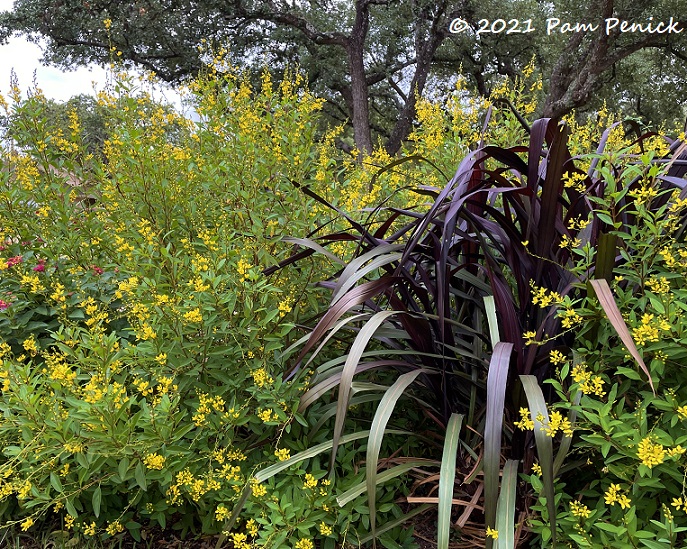
…and gives them a nice view too. Here’s the golden thryallis and ‘Vertigo’ pennisetum from their side. I dug two small divisions of an established ‘Vertigo’ root ball this spring and plopped them in this bed to fill a couple holes. Boom! They took off and now look stunning against the yellow thryallis flowers.
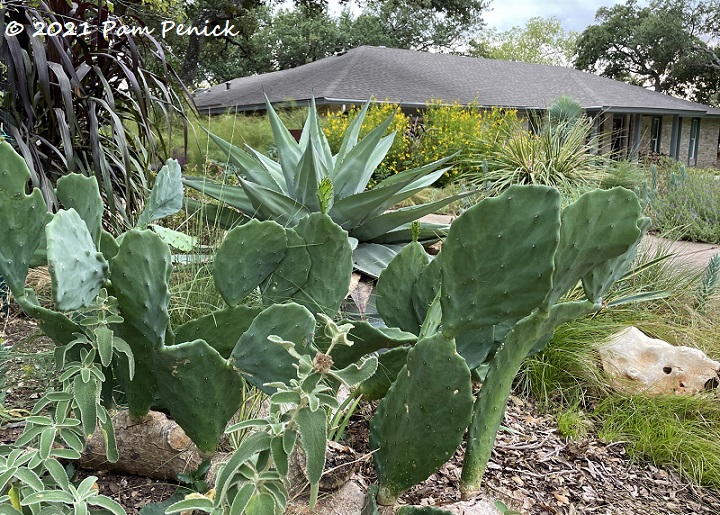
The original ‘Vertigo’ grass hulks here in the island bed (top-left), across the driveway. This bed was absolutely crushed by the February freeze. But it’s recovered well! Remember the “dinosaur bone” that remained after the ‘Old Mexico’ prickly pear (Opuntia gomei) melted? Well, here it is today. It’s a quarter of the size it was, but that woody rooted section pushed out a couple dozen new pads this summer. I expect it’ll be a monster again by end of next summer. Behind it, ‘Vanzie’ whale’s tongue agave (Agave ovatifolia) shows off its pointy-armed, star-shaped form.
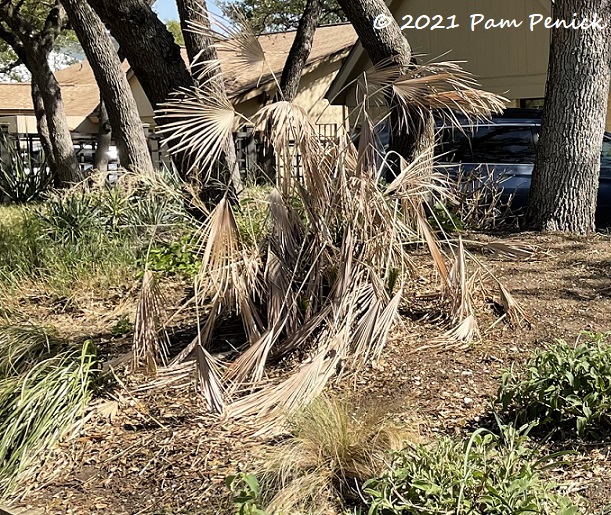
Here’s another success story — the silver Mediterranean fan palm (Chamaerops humilis var. argentea). From this in April, two months post-freeze…
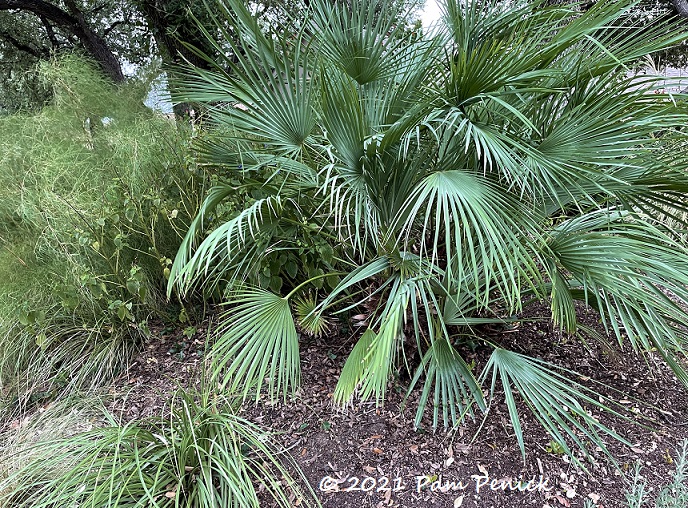
…to this in mid-September — yaaaay! I’m so relieved. It’s not yet back to its full size pre-freeze, but at this rate it should be there after next summer.
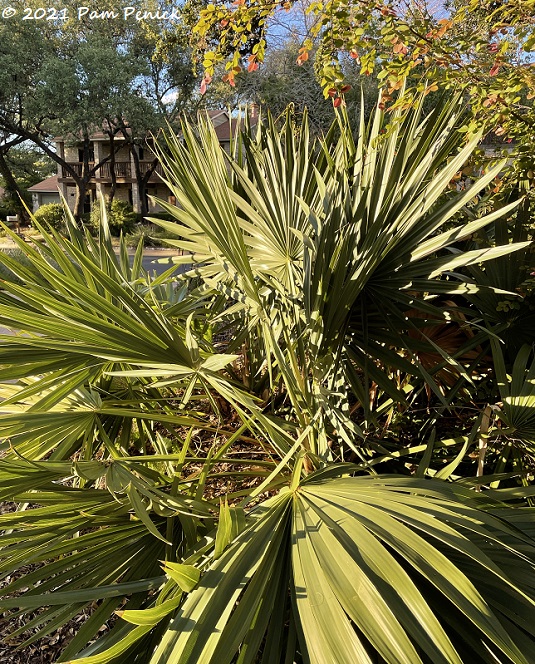
In the same island bed, native Texas dwarf palmetto (Sabal minor) never even blinked after the freeze. I am grateful for its steady, green presence in my garden all season as other plants recovered — or didn’t.
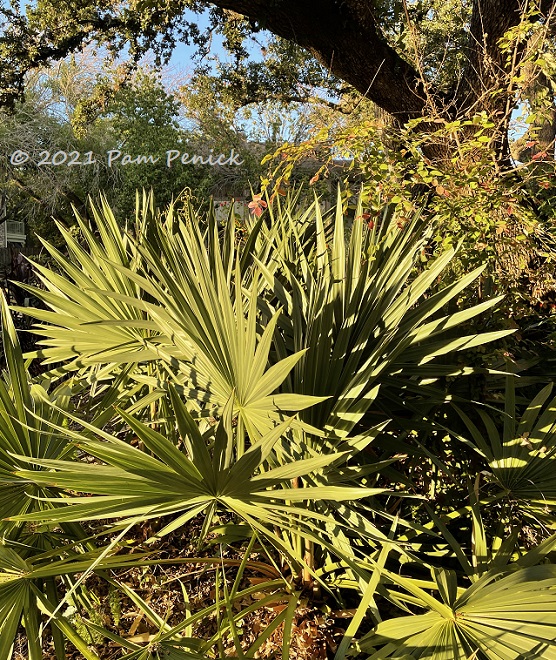
It looks particularly fetching in late afternoon, when the sun drops under the live oak canopy and lights it up, along with the ‘Rubrum’ Chinese fringeflower (Loropetalum chinense) behind it. Unfortunately all the fringeflowers in my garden were hammered by the freeze, and half of this one died. I’m hopeful it will hang on, but branches continue to die. It’s amazing how long it’s taken for some of the plants to show the full extent of the freeze damage.
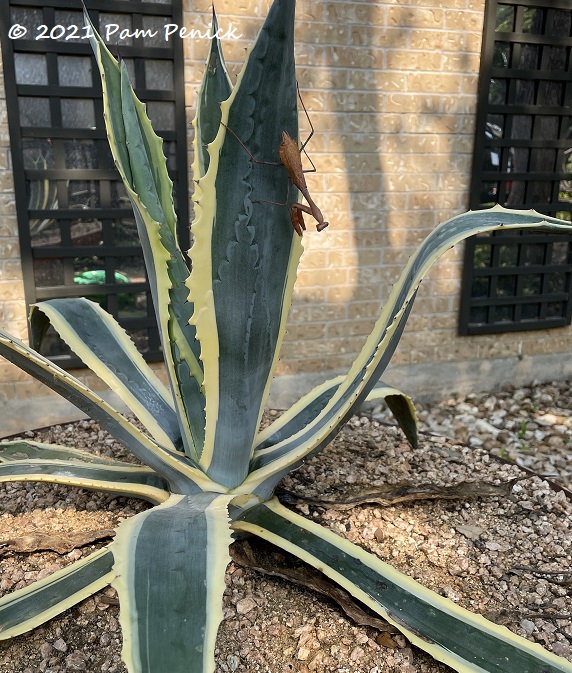
An enormous brown praying mantis caught my eye recently on the ‘Opal’ variegated American agave.
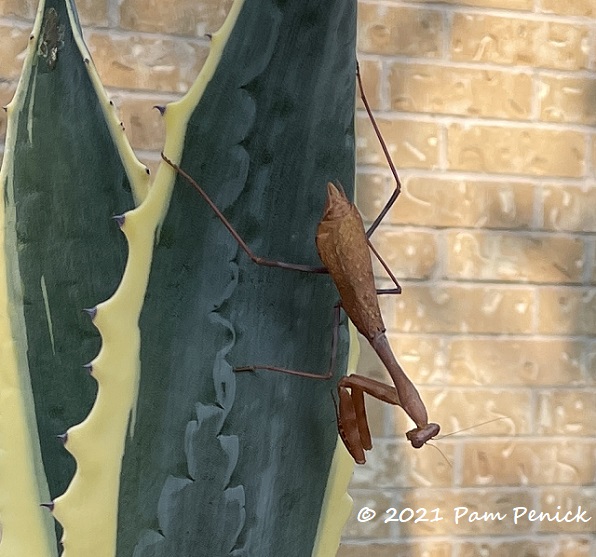
I’ve only ever seen green praying mantises in my garden before. Isn’t this the non-native one from Europe or Asia? What a monster!
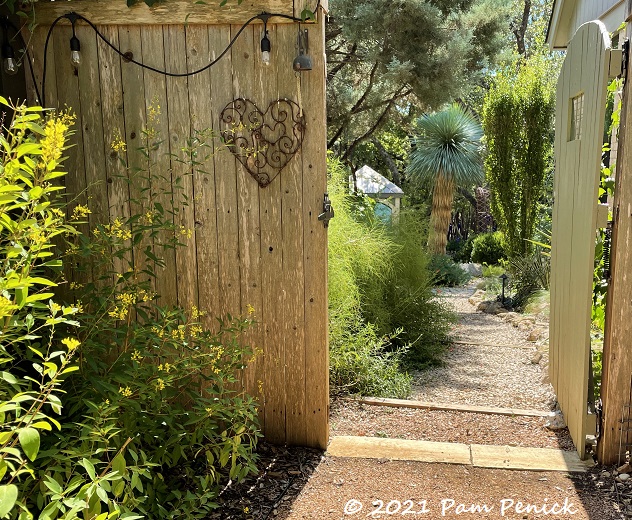
I’ve been lazy about giving my garden an end-of-summer trim for fall. Didn’t do it in August like I should have. And still haven’t done it. Which is why the path into the back garden is half-obscured by bamboo muhly, zexmenia, and flame acanthus. But I still enjoy the view down to the leaning tower of Austin — that is, my biggest and oldest ‘Sapphire Skies’ beaked yucca (Y. rostrata). What a showoff, with that 8-foot thatched trunk and powder-blue, Koosh-ball tuft of leaves!
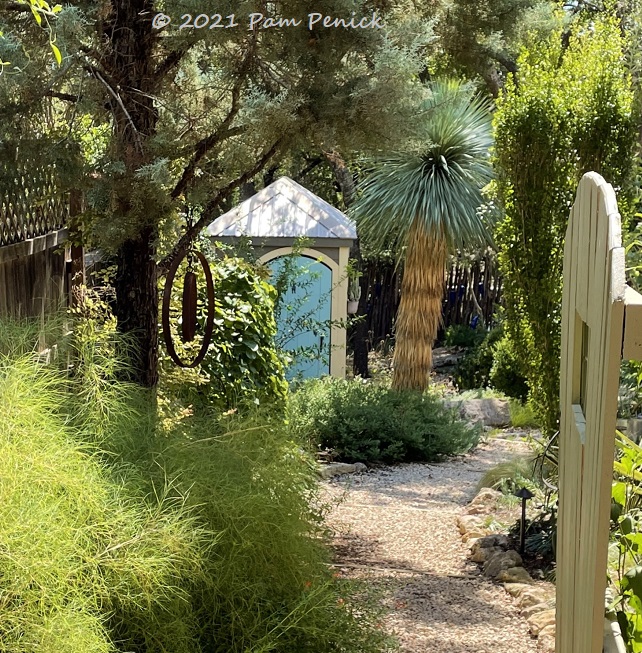
My focal-point plant may be outgrowing the focal-point space. Will the top soon be hidden behind the fluffy ‘Blue Ice’ Arizona cypress or columnar ‘Will Fleming’ yaupon holly in front? Perhaps. But do your thing, yucca! It’s been marvelous over the past 12 years to watch this yucca grow up from the tiny 3-gallon I planted. I’m curious to see just how big it will get.
__________________________
Digging Deeper
Need design help with your yard? Hire me as your personal garden coach! Maybe you need replacement plant ideas after the big freeze. Or maybe your landscaping has grown tired, and you want fresh curb appeal. Or perhaps you’re ready to get rid of some lawn and create a pollinator garden, bird habitat, or hangout space for you and your friends. I’m here to help! Contact me to let me know what’s going on, and let’s figure it out together. My range is Austin and suburbs within a 25-min. drive of NW Austin, but I’m flexible and can travel farther with a surcharge, so let me know where you are. Weekday morning appts. only.
Come learn about gardening and design at Garden Spark! I organize in-person talks by inspiring designers, landscape architects, authors, and gardeners a few times a year in Austin. These are limited-attendance events that sell out quickly, so join the Garden Spark email list to be notified in advance; simply click this link and ask to be added. Season 8 kicks off in fall 2024. Stay tuned for more info!
All material © 2025 by Pam Penick for Digging. Unauthorized reproduction prohibited.


Your garden looks much fresher to my eyes than my own, Pam. Our temperature has reached 95F this afternoon so it’s feeling much more like summer than fall at the moment. I love those oxblood lilies every time I see them – so dramatic! As to the giant praying mantis, he might provide good inspiration for a horror movie.
We were also in the mid-90s when I wrote this. But a miraculous early cool front swept through last night, and the next few days will be in the upper 80s with low humidity. That’s October weather! I’m excited. I hope fall rains come for you in L.A. soon, Kris.
What a terrific come-back your plants have made. It’s wonderful. Love the peek through your gate.–It’s magical.
As to the praying mantis, I first thought he was fake as in a fake brown metal mantis that you somehow secured to the plant. He is HUGE. While I generally like praying mantises, this one scares me a bit.
She was very big! My bug-expert friends have confirmed it’s a regular old Texas mantis, a female, and they can vary in color, which I didn’t know. The females are bigger than the males.
Amazing how your garden has bounced back.
I’m very grateful. Of course there are a number of substantial shrubs and agaves that weren’t coming back and are now gone. But I’ve got so many plants I’m not missing most of them!
Some great foliage happening there. So nice to know that not everything got wiped out in the freeze. Love those red lilies.
Not everything by a long shot. I am pretty surprised by how fast certain plants came back though, like the fan palm. I didn’t expect that, but boy am I happy about it!
Wow! The recovery of your Mediterranean fan palm is amazing. I’m so glad you waited and didn’t yank it right away. Smart gardener! As for that praying mantis, it looks fake… like someone stuck it on there to tease you.
Except her head turned! She’s out there somewhere, eating her weight in bugs and, eventually, her mate.
And yeah, I’m really happy about the fan palm recovery!
Your garden has recovered nicely, Pam. Mine has too, except that the two tall brazoria palms in back that you photographed aren’t coming back. I am waiting for the crew to remove them. Their loss will leave a different garden.
I’m sorry about your palms, Peter. That’s a hard loss. Will you replant?
Your garden looks good even if you haven’t trimmed it back. Some years are just like that.
They sure are – ha!
After the fallout it’s always interesting to see who will respond positively or just fade away. Helps with the discouragement a major weather event can instill in a gardener. It looks like so many of your plants have recovered really well and are big and beautiful. The Pennisetum is truly gorgeous in the sea of yellow. Was told once that woody plants can take up to 7 years before they succumb to a major stress event so unfortunately, you will probably see more plants pack it in.
That’s not a happy factoid, but I’ll be keeping track, so it’ll be interesting to see if it pans out. Hopefully all the ones that are going to croak have already been showing the signs of struggle, as I’ve come to terms with those.
The survivors are certainly looking feisty and flourishing. That is encouraging and reassuring after the first shock.
Similar to people enjoying spectacular spring flowers on Rondebosch Common after the heartbreak of a fire.
Good metaphor re: rejuvenation after a fire. And thank heavens for it!